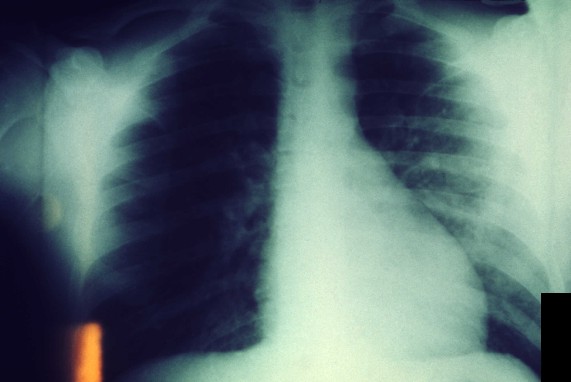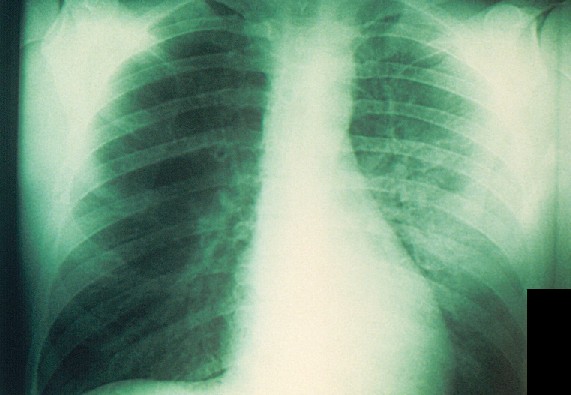Pneumonic plague
Template:Pneumonic plague Editor-In-Chief: C. Michael Gibson, M.S., M.D. [1]
Overview
Pneumonic plague, a severe type of lung infection, is one of three main forms of plague, all of which are caused by the bacterium Yersinia pestis. It is more virulent and rare than bubonic plague. The difference between the versions of plague is simply the location of the infection in the body; the bubonic plague is an infection of the lymphatic system, the pneumonic plague is an infection of the respiratory system, and the septicemic plague is an infection in the blood stream.
Typically, pneumonic form is due to a spread from infection of an initial bubonic form. Primary pneumonic plague results from inhalation of fine infective droplets and can be transmitted from human to human without involvement of fleas or animals. Untreated pneumonic plague has a very high fatality rate.
Pathophysiology
Pneumonic plague can be caused in two ways: primary, which results from the inhalation of aerosolised plague bacteria, or secondary, when septicemic plague spreads into lung tissue from the bloodstream. Pneumonic plague is not exclusively vector-borne like bubonic plague; instead it can be spread from person to person. There have been cases of pneumonic plague resulting from the dissection or handling of contaminated animal tissue. This is one type of the formerly known Black Death.[1] It could kill 90%–95% of a population if the victims coughed and passed on the bacteria.
Differentiating Pneumonic Plague from other Diseases
Pneumonic Plague
- Inhalational anthrax (Bacillus anthracis)
- Widened mediastinum and pleural effusions seen on CXR or chest CT.
- Not true pneumonia; minimal sputum production.
- Hemoptysis uncommon (if present, suggests diagnosis of plague).
- Tularemia (Francisella tularensis)
- Clinical course not as rapid or fulminant as in pneumonic plague.
- Mycoplasmal pneumonia (Mycoplasma pneumoniae)
- Rarely as fulminant as pneumonic plague.
- Pneumonia caused by Chlamydia pneumoniae
- Rarely as fulminant as pneumonic plague.
- Legionnaires' disease (Legionella pneumophila or other Legionella species)
- Rarely as fulminant as pneumonic plague.
- Community outbreaks of Legionnaires' disease often involve exposure to cooling systems.
- Legionellosis and many other diseases caused by bacterial agents (S aureus, S pneumoniae, H influenzae, K pneumoniae, M catarrhalis) usually occur in persons with underlying pulmonary or other disease or in the elderly.
- Psittacosis (Chlamydia psittaci)
- Rarely as fulminant as pneumonic plague.
- Result of bird exposure.
- Other bacterial agents (e.g., Staphyloccocus aureus, Streptococcus pneumoniae, Haemophilus influenzae, Klebsiella pneumoniae, Moraxella catarrhalis)
- Rarely as fulminant as pneumonic plague.
- Usually occur in persons with underlying pulmonary or other disease or in the elderly.
- Influenza
- Influenza generally seasonal (October-March in United States) or involves history of recent cruise ship travel or travel to tropics.
- Hantavirus
- Exposure to excrement (urine or feces) of mice with Hantavirus.
- RSV
- RSV usually occurs in children (although may be cause of pneumonia in elderly); tends to be seasonal (winter/spring).
- CMV
- CMV usually occurs in immunocompromised patients.
- Q fever (Coxiella burnetii)
- Exposure to infected parturient cats, cattle, sheep, goats.
- Severe pneumonia not prominent feature.
Epidemiology and Demographics
Since 2002, the World Health Organization (WHO) has reported seven plague outbreaks, though some may go unreported because they often happen in remote areas. Between 1998 and 2009, nearly 24,000 cases have been reported, including about 2,000 deaths, in Africa, Asia, the Americas and Eastern Europe. 98 percent of the world's cases occur in Africa.
Natural History and Prognosis
Natural History
The pneumonia progresses for two to four days and may cause respiratory failure and shock. Patients will die without early treatment, some within 36 hours.
Prognosis
Pneumonic plague is a very aggressive infection requiring early treatment. The mortality rate from untreated pneumonic plague approaches 100%.
Diagnosis
Symptoms
The most apparent symptom of pneumonic plague is coughing, often with hemoptysis (coughing up blood). With pneumonic plague, the first signs of illness are fever, headache, weakness, and rapidly developing pneumonia with shortness of breath, chest pain, cough, and sometimes bloody or watery sputum.
Initial pneumonic plague symptoms can often include:
Rapidly developing pneumonia with:
- Shortness of breath
- Chest pain
- Cough
- Bloody or watery sputum (saliva and discharge from respiratory passages).
Imaging
Chest X Ray
Pneumonic plague is rapidly progressive. Patients experience increasing dyspnea, stridor, and cyanosis. Rapidly progressive respiratory failure and sepsis within 2 to 4 days of onset of illness is typical of pneumonic plague.
Chest x-rays can be variable but frequently show bilateral patchy infiltrates or consolidation, such as the 1st image below.
Treatment
Medical Therapy
Antibiotics must be given within 24 hours of first symptoms to reduce the risk of death.[2] Streptomycin, gentamicin, tetracyclines, and chloramphenicol are all effective against pneumonic plague.
Antibiotic treatment for 7 days will protect people who have had direct, close contact with infected patients. Wearing a close-fitting surgical mask also protects against infection.
Related Chapters
References
- ↑ Benedictow, Ole Jørgen (2004). The Black Death, 1346-1353: the complete history. Boydell & Brewer. pp. 27–28. ISBN 0-85115-943-5.
- ↑ Facts about Pneumonic Plague (Center for Disease Control, 2004)
External Links
- Facts about Pneumonic Plague. Centers for Disease Control and Prevention.


